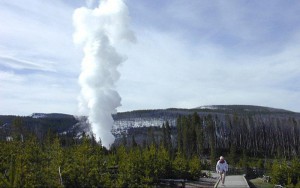- Slug: Yellowstone volcano, 600
- Photos available (thumbnails, captions below)
By KAITLYN THOMPSON
Cronkite News
TEMPE – Christy Till and her team of Ph.D. students had a rare opportunity to spend a week and a half inside Yellowstone National Park, collecting samples of lava, dodging tourists and sleeping in tents.
Their goal? Determine the likelihood that the volcano will erupt.
“I thought it was absolutely amazing to go to Yellowstone. It was the best week of my life,” said Hannah Shamloo, 23, a member of the magma studying team, Experimental Petrology and Igneous processes Center at Arizona State University.
The team was given special access to Yellowstone, where they explored locations not available to the general public. Officials advised the group to stay out of view of others while doing their work. Shamloo said that going out into the field and working with a leading scientist made it a rewarding experience.
The lab group collected samples of the magma and the minerals lodged within it and brought them back to their laboratory in Tempe.
An eruption of the Yellowstone Caldera volcano in Wyoming could cause catastrophic destruction. The largest eruption in its history, the Lava Creek Tuff eruption, expelled about 1,000 cubic kilometers of material 640,000 years ago. That’s about the distance in miles it takes to get to Las Vegas from Phoenix, Till said.
The likelihood of Yellowstone erupting anytime soon is extremely low, said Till, who gave a lecture on Jan. 21 to discuss the group’s findings and the science behind volcano eruptions.
There are about 1,500 active volcanoes in the world, and 95 percent of them rest on the earth’s plate boundaries. The remaining 5 percent of volcanoes, like the one in Yellowstone and those found in Hawaii, can potentially cause larger eruptions than the ones on plates boundaries, said Till, a geologist and assistant professor at ASU.
The magma beneath volcanoes rises, accumulates and forms magma chambers in the volcano’s surface, where it can solidify or continue building until eruption. Till said there is a prevailing hypothesis why volcanoes erupt periodically rather than constantly spewing magma.
“Magma causes eruptions when there is a new injection of magma in the system. Magma has risen through the system, it’s sitting there, it’s stalled in different places in the crust,” Till said. “Then you have a new injection of magma that reheats and reenergizes the magma, and that is what causes the eruption.”
To discover the likelihood of another eruption at Yellowstone, the team carefully examined the samples.
“The key is to think about tree rings,” Till said. “We cannot only tell how old a tree is by counting the rings, but we can tell information about the environment the tree was growing in. It turns out that minerals do the same thing.”
The team separated the minerals from the magma and looked at their zones under a microscope. The zones show the temperature of the mineral over time and any changes in the composition, and changes may indicate a potential eruption.
“This is exactly what we would predict if there was a magma intrusion,” Till said.
The Yellowstone Volcano Observatory, a combined force of the National Park Services and U.S. Geological Survey, monitors Yellowstone every day for signs of an eruption forming, but the chance of it occurring any time soon is rather low.
Till said the probability of a giant eruption this year is 1 in 730,000.
“Not out of the realm of possibility, but very unlikely of happening,” she said. “The probability of it having any kind of eruption at all, a small lava eruption, is 1 in 10,000.”
^__=

